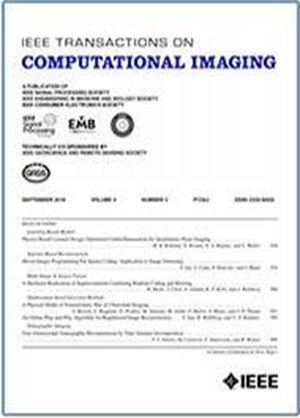生物发光层析成像残差图模型学习网络
IF 4.8
2区 计算机科学
Q2 ENGINEERING, ELECTRICAL & ELECTRONIC
引用次数: 0
摘要
对于生物发光层析重建,正则化算法和深度学习框架已经得到了广泛的研究,并取得了令人印象深刻的成果。然而,正则化算法的参数选择和深度学习方法的可解释性差成为影响重构结果和阻碍其适用性的关键因素。为了缓解这一问题的影响,本文结合正则化方法和深度学习的优点,提出了一种新的残差图模型学习网络(RGMLN)用于生物发光层析成像重建。RGMLN是基于阈值迭代收缩算法的推理过程。区别在于正则化方法的惩罚项被残差分布和源分布之间可学习的非线性映射所取代,以保证网络的可解释性。同时,考虑到有限元网格的非欧几里得特性,利用四面体网格的拓扑信息,进行基于拉普拉斯图论的图卷积运算,对网格节点进行特征聚合。最后,基于残差学习和自编码器策略,设计了梯度下降和近似映射模块来构建模型驱动的RGMLN方法,以充分利用迭代技术的可解释性和学习方法的灵活性。数值和体内实验均证实了该网络具有良好的定位精度,可适用于不同的网格和波长。本文章由计算机程序翻译,如有差异,请以英文原文为准。
RGMLN:Residual Graph Model Learning Network for Bioluminescence Tomography
For bioluminescence tomography reconstruction, regularization algorithms and deep learning frameworks have been widely studied and achieved impressive results. However, the parameter selection of the regularization algorithm and the poor interpretability of deep learning methods have become the key factors that affect the reconstruction results and hinder its applicability. To mitigate the effects of this problem, in this paper, we proposed a novel residual graph model learning network (RGMLN) for bioluminescence tomography reconstruction by combining the advantages of regularization method and deep learning. RGMLN is based on the inference process of the thresholding iterative shrinkage algorithm. The difference is that the penalty term of the regularization method was replaced by a learnable nonlinear mapping between the residual and source distributions to ensure the interpretability of network. Meanwhile, considering the non-Euclidean property of the finite element mesh, a graph convolution operation based on Laplacian graph theory was conducted to aggregate features of mesh nodes using the topological information of the tetrahedral mesh. Lastly, based on residual learning and auto-encoder strategies, gradient descent and prox mapping modules were designed to structure the model-driven RGMLN method to take advantage of both the interpretability of iterative techniques and the flexibility of learning methods. Both numerical and in vivo experiments confirmed that the proposed network has excellent positioning accuracy and can be applied to different meshes and wavelengths.
求助全文
通过发布文献求助,成功后即可免费获取论文全文。
去求助
来源期刊

IEEE Transactions on Computational Imaging
Mathematics-Computational Mathematics
CiteScore
8.20
自引率
7.40%
发文量
59
期刊介绍:
The IEEE Transactions on Computational Imaging will publish articles where computation plays an integral role in the image formation process. Papers will cover all areas of computational imaging ranging from fundamental theoretical methods to the latest innovative computational imaging system designs. Topics of interest will include advanced algorithms and mathematical techniques, model-based data inversion, methods for image and signal recovery from sparse and incomplete data, techniques for non-traditional sensing of image data, methods for dynamic information acquisition and extraction from imaging sensors, software and hardware for efficient computation in imaging systems, and highly novel imaging system design.
 求助内容:
求助内容: 应助结果提醒方式:
应助结果提醒方式:


